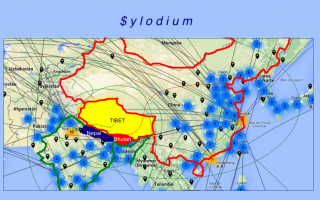China to construct Market Complex In Tibet
Preliminaries
Tibet
Britain supported Tibetan autonomy under the 13th Dalai Lama but did not contest Chinese suzerainty; while "Inner Tibet", areas such as Amdo and Kham with mixed Chinese and Tibetan populations to the east and north, remained nominally under the control of the Republic of China although that control was seldom effective.
Though the sovereignty of Tibet was unrecognized, Tibet was courted in unofficial visits from Nazi Germany, Imperial Japan, and the United States during and after World War II.
The foreign relations of Tibet ended with the Seventeen Point Agreement that formalized Chinese sovereignty over most all of political Tibet in 1951.
today, The central region of Tibet is an autonomous region within China, the Tibet Autonomous Region. The Tibet Autonomous Region is a province-level entity of the People's Republic of China
Tibet – China
Tibetan foreign relations during the Ming Dynasty are opaque, with Tibet being either a tributary state or under full Chinese sovereignty.
But by the 18th century, the Qing Dynasty indisputably made Tibet a subject.
In the early 20th century, after a successful invasion, Britain established a trading relationship with Tibet and was permitted limited diplomatic access to "Outer Tibet", basically Shigatse and Lhasa.
In 1949 Mao won the Civil War of the Communist Party against the Government of Xian Kai-shek and proclaimed the People's Republic of China.
In 1950, the Chinese army invaded Tibet.
In 1951, Tibetan leaders signed a treaty that puts the region under the administration of China.
In 1994, the Tibetan community in Switzerland accused China of the death of 1.2 million Tibetans.
West has for many years maintained a double standard, negotiating directly with Tibet in many cases, which has complicated the real status of Tibet.
in 1979 the Dalai Lama advocated for the "middle way", which involves the renunciation of independence in exchange for autonomy so that Tibet preserve their identity.
In 2005, the Dalai Lama accepted in an interview that Tibet is part of the PRC.
Chinese President of Tibet, Qiangba Puncog, said that the population of the region "fight against separatism in favor of the unified country, and towards maintaining stability."
For China, Tibet sovereignty is not negotiable. However China is willing to discuss the degree of cultural and religious autonomy of the region, and the conditions of return of the Dalai Lama.
Tap Sylodium (the global platform for bilateral trade) you can advertise for free your company or your project, at the intersection of cities that you want,
Tibet – Nepal
The Nepalese–Tibetan War was fought from 1855 to 1856 in Tibet between the forces of the Tibetan government under administrative rule of the Qing dynasty) and the invading Nepalese army.
Tibet – India
the 7th century onward, when Buddhism was introduced by missionaries from India.
Tourism business, import export business, traders, from Pakistan to China….

China – Nepal
Since the Sino-Nepalese War of 1792, the Nepalese government had renounced all claims of influence in Tibet and maintained a policy of non-intervention in its affairs. the Qing Empire victory made Nepal a tributary state, but the wave of rebellions that afflicted China in the 1850s was an excellent opportunity to press for Nepalese objectives in Tibet without the threat of Chinese interference.
Today, Both have bilateral relationships friendly defined by Nepal's policy of balancing the competing influence of China and Nepal's southern neighbour India,
Work with us, representing Pakistan with rest of the world, for example.
India - Nepal
Modern-day India and Nepal initiated their relationship with the 1950 Indo-Nepal Treaty of Peace and Friendship : stated that "neither government shall tolerate any threat to the security of the other by a foreign aggressor" and obligated both sides "to inform each other of any serious friction or misunderstanding with any neighbouring state likely to cause any breach in the friendly relations subsisting between the two governments."
The Indo-Nepal border is open;
However, Since 2015, cultural and political issues have strained relations between the two countries with anti-Indian sentiment growing amongst the government and people of Nepal.
Participate with your ideas and win until 3.000 dollars in Forum-Business-Contest
China has commenced the construction of a USD 30 million commercial complex in Tibet near the Indo-Nepal border aimed at boosting trade with Nepal. the Tanggar International Border Trade Market covers an area of 72,403 square meters and will receive a total investment of 195 million yuan (USD 30 million). The market, once built, will become a commercial complex that incorporates merchandise trade, business, leisure, logistics and storage. China has opened up it border with Tibet to supply petroleum and other essential products to Nepal during recent agitation against the new Constitution that restricted supplies from the Indian side.
If you'd want to reach new business realities between India and USA, join us as Premium user to take advantage of our global Barter(transactions), segmentation Banner, and our 2 business networkings
SYNERGIES TO EXPLORE WITH SYLODIUM,
For example,
NEPAL CHINA CHAMBER OF COMMERCE (NCCCI)
8th China-South Asia Business Forum (CSABF)
And mutual embassies
Sylodium
Become a Premium user
1 WORK WITH US .
take a look to our coming

